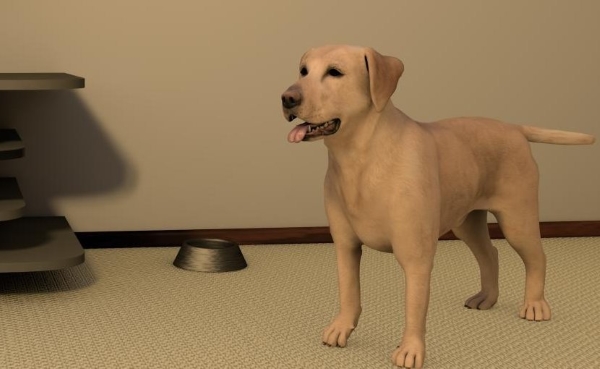[This case study report from the Virtual Engineering Centre (VEC) at the University of Liverpool describes a unique and potentially valuable application of presence-evoking technology to help people learn the warning signs that a dog is likely to bite them. The link at the end leads to a 1:19 minute video of a first-person interaction with a virtual dog. –Matthew]

CASE STUDY: THE DOGS TRUST
The Virtual Engineering Centre, in collaboration with Dogs Trust, the University of Liverpool’s Institute of Infection and Global Health and Institute of Psychology, Health and Society, have created an immersive 3D environment to demonstrate the value of digital technologies in the identification and education of canines body language related to aggression.
THE CHALLENGE
6,740 hospital admissions for dog bites and strikes were recorded in the UK in 2013 and University of Liverpool research suggests that the burden of dog bites is considerably larger than those estimated from hospital records.
Dogs Trust is keen to better educate children and adults about the early identification of signs of aggressive behaviour within dogs in order to enable better prevention within the UK.
Dogs Trust wanted to help people to identify a range of stress and threat behaviours typically exhibited by dogs which have the potential to lead to a dog biting a person. The charity is therefore interested in understanding whether a digital model could help people to identify these signs and provide the ability to communicate, in particular to children, when a dog may not wish to interact and therefore becomes aggressive. This would helping to improve both animal and human welfare in the future.
THE SOLUTION
Dogs Trust was introduced to the Virtual Engineering Centre (VEC) by academics from the University of Liverpool‘s Institute of Infection and Global Health, working in the Institute of Veterinary Science. The VEC aimed to create a proof of concept, immersive environment which would support academic research into further preventing dog bites. This could then be used as an educational tool, enabling users to better understand animal behaviour, in particular human-dog interaction and early signs of aggression.
A team of animal behaviourists worked closely with the VEC to make certain that the body language and detail shown in the virtual environment was both realistic and a truthful reflection of real world canine behaviour. The result was an environment in which adults and children could approach and interact with a dog in a safe and controlled way and highlight hostile signals displayed by the dog which could potentially lead to an attack or incident if not correctly identified.
The immersive Virtual Reality (VR) experience allows a person to approach the dog, and as the person gets closer, the behaviour and body language of the dog gradually changes, the dog’s behaviour begins to display signs of aggression including licking its lips, lowering of the head and body, front paw lifting, growling, and showing of teeth. These behaviours are referenced from the ‘Canine Ladder of Aggression’ which shows how a dog may behave when it does not want to be approached.
THE BENEFITS
This proof of concept tool has already demonstrated that immersive experiences can be used by organisations such as Dogs Trust as an educational tool which can be conducted in a safe environment and that there is value in developing tools of this nature further.
Next steps will look to enhance the detail within the immersive environment, in partnership with animal behavioural specialists and psychologists to ensure the simulation is as realistic and provides the highest level of immersive experience as possible.
Using VR can help to engage and improve the interest felt within a classroom environment, and the use of VR headsets often helps people to overcome any learning disability or language barrier.
Seeing the change in the dog’s body language through a realistic immersive environment may accelerate the learning of the user when compared to traditional vocal teaching. Although the simulation can feel very realistic, the virtual environment keeps users safe, allowing them to sensepotentially dangerous environmentsand learn to adopt appropriate behaviours.
Future developments will show a wider range of dog behaviours and reactions to user behaviour. These can help to showcase human behaviour and the way in which dogs may find people threatening.
Click here to see the changing behaviour in our virtual dog.